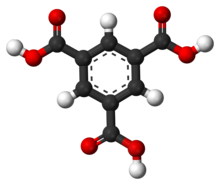Trimesic acid
Appearance

| |

| |
| Names | |
|---|---|
| IUPAC name
benzene-1,3,5-tricarboxylic acid
| |
| Identifiers | |
3D model (JSmol)
|
|
| ChEBI | |
| ChEMBL | |
| ChemSpider | |
| DrugBank | |
| ECHA InfoCard | 100.008.253 |
| EC Number |
|
PubChem CID
|
|
| UNII | |
CompTox Dashboard (EPA)
|
|
| |
| |
| Properties | |
| C9H6O6 | |
| Molar mass | 210.14034 |
| Acidity (pKa) | 3.12, 3.89, 4.70[1] |
| Hazards | |
| Safety data sheet (SDS) | Oxford MSDS |
Except where otherwise noted, data are given for materials in their standard state (at 25 °C [77 °F], 100 kPa).
| |
Trimesic acid, also known as benzene-1,3,5-tricarboxylic acid, is a benzene derivative with three carboxylic acid groups.
Trimesic acid is a planar molecule (and is one of only four benzenecarboxylic acids with that property).[2]
Trimesic acid can be combined with para-hydroxypyridine to make a water-based gel, stable up to 95 °C.[3]
Trimesic acid crystallizes from water in a hydrogen-bonded hydrated network with wide unidimensional empty channels.[4]
See also
References
- ^ Brown, H.C.; McDaniel, D.H.; Häfliger, O. (1955). "Chapter 14—Dissociation Constants". In Braude, E.A.; Nachod, F.C. (eds.). Determination of Organic Structures by Physical Methods. New York: Academic Press. doi:10.1016/B978-1-4832-3166-2.50018-4.
- ^ Marković, Zoran; Badjuk, Dalibor; Gutman, Ivan (2004). "Geometry and conformations of benzenecarboxylic acids". J. Serb. Chem. Soc. 69 (11): 877–882. doi:10.2298/JSC0411877M.
- ^ Tang, Li Ming; Wang, Yu Jiang (2009). "Highly stable supramolecular hydrogels formed from 1,3,5-benzenetricarboxylic acid and hydroxyl pyridines". Chinese Chemical Letters. 20 (10): 1259–1262. doi:10.1016/j.cclet.2009.04.030.
- ^ Herbstein, Frank H. (1987). "Structural Parsimony and Structural Variety Among Inclusion Complexes (with particular reference to the inclusion compounds of trimesic acid, N-(p-tolyl)-tetrachlorophthalimide, and the heilbron "complexes")". Top. Curr. Chem. Topics in Current Chemistry. Vol. 140. pp. 107–139. doi:10.1007/bfb0003838. ISBN 3-540-17307-2.
